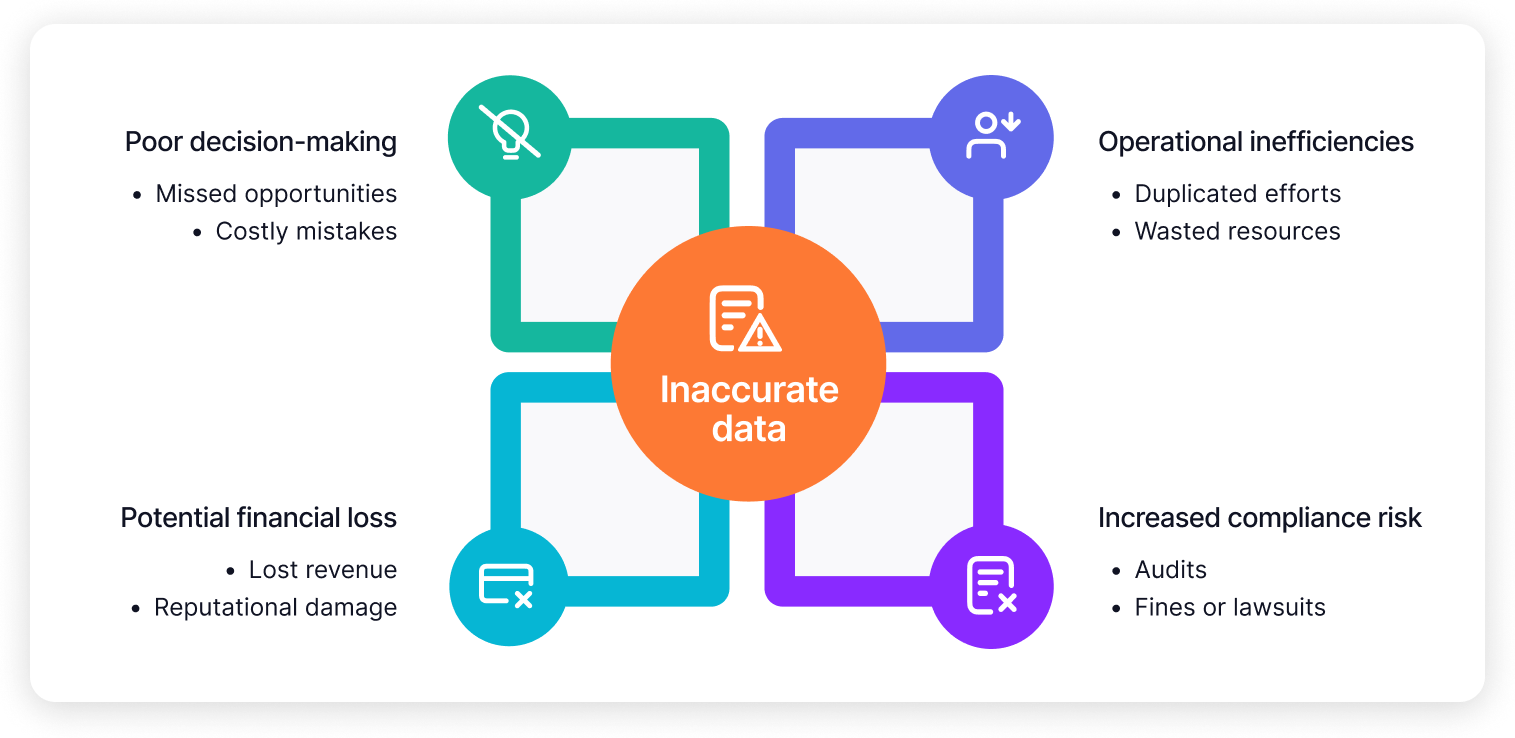How to Ensure Data Accuracy Across Your Organization
Learn how to maintain data accuracy across your organization with proven strategies to improve decision-making, reduce errors, and ensure compliance.
The reliability of business decisions hinges on one key factor: data accuracy. However, as organizations scale, managing data accuracy becomes more complex, with errors creeping in from multiple sources, manual input, and outdated systems. The cost of these inaccuracies can be far-reaching, from poor decision-making and operational inefficiencies to serious regulatory risks.
To thrive, your organization must prioritize strategies that ensure data remains accurate at all touchpoints, turning data into a true competitive advantage.
Understanding the concept of data accuracy
Data accuracy refers to the degree to which data correctly reflects the real-world entities or conditions it is meant to represent. In simple terms, accurate data is correct, precise, and free from errors or distortions. If you enter a customer's address into a database, it should be the exact, up-to-date information that matches the customer's actual location. The customer’s information is inaccurate if it includes an error, such as a misspelled address.
Data accuracy is one of the key dimensions of data quality, which is a broader concept that encompasses various factors, including data accuracy, consistency, completeness, and timeliness. Because it’s only one part of data quality, accurate data may not cover all these factors. For example, data can be accurate but incomplete, such as having a customer's correct address but missing their phone number.
Challenges to maintaining data accuracy
Maintaining data accuracy is a constant challenge for organizations due to several factors, such as:
- Data integration issues: As enterprises adopt more tools and systems, they often encounter misalignment between data sets, especially when those sources come from different departments or external partners. This lack of cohesion makes it harder to reconcile conflicting data and align everything correctly.
- Human error: Even with the best tools, human error remains a common cause of inaccurate data. Whether it’s manual data entry mistakes or the misinterpretation of information, human involvement in data processes is often a double-edged sword.
- System limitations: When systems don’t talk to each other or when you store data in incompatible formats, it’s tough to maintain accurate, up-to-date records. Poor data architecture also prevents the smooth flow of information, leading to gaps or discrepancies in the data.
- Data volume: As the amount of data grows, so do the risks of inaccuracies. Manual processes and even semi-automated ones can’t keep up with the volume, leading to errors that may go unnoticed until they affect key decisions or operations.
- Lack of standardization: Without clear standards for data entry, departments may create their own systems, leading to data inconsistencies. If one team enters data in a different format from another, or if there are variations in naming conventions, ensuring accuracy across your organization becomes a major challenge.
The impact of inaccurate data on business performance
Inaccurate data can severely impact business performance in various ways:

Poor decision-making
One of the most direct consequences of inaccurate data is poor decision-making. Executives and managers rely on data to make critical business decisions, whether it’s forecasting, planning budgets, or setting strategy. If that data is inaccurate, decisions made based on it will be flawed, leading to missed opportunities or costly mistakes.
Operational inefficiencies
Inaccurate data can also lead to operational inefficiencies. When departments are working with outdated or incorrect data, teams may duplicate efforts, waste resources, or operate with incorrect assumptions. This leads to missed deadlines, redundant work, and unnecessary delays in project timelines.
Increased compliance risk
In sectors like healthcare, finance, and pharmaceuticals, the stakes are even higher. Inaccurate data could lead to non-compliance with industry regulations, triggering audits, fines, or even lawsuits. Maintaining data accuracy isn’t just good business practice—it’s often required by law to meet regulatory standards.
Potential financial loss
Inaccurate data can also have a financial toll. Whether it’s through lost revenue due to errors in sales data, regulatory fines, or reputational damage, the financial repercussions of inaccurate data are real. For example, when incorrect customer data leads to a failed product launch, the company risks not only direct revenue loss but also long-term brand damage. Additionally, operational disruptions caused by inaccurate data can result in increased costs and lost productivity.
Best practices for maintaining data accuracy
Follow the best practices below to foster a data-driven environment where everyone bases their decisions on reliable, consistent, and high-quality information.
1. Implement data governance policies
Establishing strong data governance policies is essential for maintaining data accuracy across your organization. These policies ensure that data entry, validation, and management follow predefined rules and standards, making it easier to keep data accurate over time. By defining who is responsible for managing specific datasets, setting data entry protocols, and establishing validation rules, governance provides the necessary structure for consistent data handling.
Moreover, governance helps standardize data processes across departments, reducing discrepancies caused by varying practices. For example, implementing guidelines for data formats (such as how you record dates, addresses, and phone numbers) ensures uniformity organization-wide. Clear policies should also include regular audits to monitor data quality and compliance with the governance framework. These audits are critical for identifying inaccuracies before they affect business operations or decision-making.
2. Use automated data cleaning tools
Automated data cleaning tools can significantly improve data accuracy by detecting and correcting errors in real time. These tools are designed to identify issues such as duplicate values, missing values, and incorrect formats. Then, they either fix them automatically or flag them for review. By integrating these tools into the data pipeline, you can clean and verify data as it enters your systems.
Automated cleaning tools can also help you scale data processes without compromising accuracy. For large enterprises handling vast amounts of data, manual data validation is simply not feasible. Automated tools can handle the repetitive, error-prone task of data cleaning, saving employees time. These tools also ensure that data remains accurate across multiple systems, as they integrate with existing data platforms to clean data in real time.
3. Validate datasets early
As part of your data accuracy endeavor, you should build validation processes into data workflows. These processes verify that data meets specific criteria, like accuracy. Validating data both at the point of entry and during updates can help you catch errors early, before they propagate throughout the system. Whether it’s checking for missing values or confirming data against external benchmarks, regular validations provide an additional layer of protection against inaccuracies.
This ongoing attention to data quality ensures that your organization doesn’t just react to data errors but takes a proactive approach to maintaining the integrity of its data systems.
4. Conduct regular data audits
Regular data audits help ensure data accuracy by identifying discrepancies, outdated information, or inconsistencies that might have slipped through earlier validation checks. By periodically reviewing data, you can uncover hidden errors that could compromise decision-making or operational efficiency.
Audits also provide an opportunity to reassess data management practices, identify gaps in processes, and implement corrective actions where necessary. Additionally, they’ll keep your business compliant with industry regulations, which reduces the risk of potential legal or financial repercussions. By making data audits a routine part of data governance, you can proactively maintain data accuracy, boosting overall trust and reliability in your data-driven initiatives.
5. Build a culture of data accuracy
Building a culture that prioritizes data accuracy can lead to long-term success. While data accuracy training is a part of creating this culture, you must also foster a collective mindset that values accuracy at every step of the data lifecycle. When employees at all levels understand that data quality directly impacts decision-making, operational efficiency, and business outcomes, they’re more likely to take ownership of the data they work with.
Creating this culture starts with leadership. Leaders must set the tone by consistently emphasizing the importance of data accuracy in all business processes and decisions. This could be through regular communications, company-wide goals around data integrity, or recognizing teams that maintain high data quality standards. The more you integrate data accuracy into the company's values, the more likely it is for every employee to embrace it.
When it comes to training programs, ensure they focus on technical skills and cultivating an appreciation for data quality. This will educate employees about the wider implications of inaccurate data and empower them to spot errors, ask questions, and raise concerns. By encouraging proactive involvement in data management, your organization can avoid the common pitfalls of siloed or reactive data practices. This focus on accountability, transparency, and teamwork can make sure that data accuracy isn't just the responsibility of one department but a shared goal with all teams.
Make data accuracy an organization-wide responsibility with Prophecy
Data accuracy is not just the responsibility of the data team—it's a collective effort that requires the involvement of every employee. Prophecy empowers your teams to actively participate in maintaining data accuracy, helping you ensure reliable, consistent, and actionable data across every department. That way, everyone in your organization can contribute to upholding data integrity, making better decisions, and minimizing risks.
Here’s how Prophecy makes data accuracy a shared responsibility:
- Automated data validation: Prophecy automates data validation at every stage of the data pipeline, helping you catch inaccuracies early. This reduces the need for manual oversight and enables employees to maintain data integrity throughout their workflows.
- User-friendly interface: Prophecy’s intuitive, no-code platform allows non-technical employees to easily clean, manage, and monitor data accuracy, empowering them to take action without requiring deep technical expertise.
- Cross-system data integration: Prophecy seamlessly integrates with your existing systems, ensuring that data in different departments and platforms remains consistent and aligned. Every team can then work from the same accurate dataset.
- Real-time data audits: Prophecy supports continuous, automated data audits, allowing teams to regularly monitor data quality and correct discrepancies before they affect business operations. This makes data accuracy a proactive, organization-wide effort.
Find out how Aetion, a leading healthcare technology company, used Prophecy to allow their healthcare teams to use accurate, real-world evidence data in our webinar: Aetion Revolutionizes Healthcare with Prophecy’s AI Data Transformation.
Ready to give Prophecy a try?
You can create a free account and get full access to all features for 21 days. No credit card needed. Want more of a guided experience? Request a demo and we’ll walk you through how Prophecy can empower your entire data team with low-code ETL today.
Ready to see Prophecy in action?
Request a demo and we’ll walk you through how Prophecy’s AI-powered visual data pipelines and high-quality open source code empowers everyone to speed data transformation
Get started with the Low-code Data Transformation Platform
Meet with us at Gartner Data & Analytics Summit in Orlando March 11-13th. Schedule a live 1:1 demo at booth #600 with our team of low-code experts. Request a demo here.
Related content
A generative AI platform for private enterprise data
Introducing Prophecy Generative AI Platform and Data Copilot
Ready to start a free trial?
Lastest posts

The Future of Data Is Agentic: Key Insights from Our CDO Magazine Webinar

Analytics as a Team Sport: Why Data Is Everyone’s Job Now




